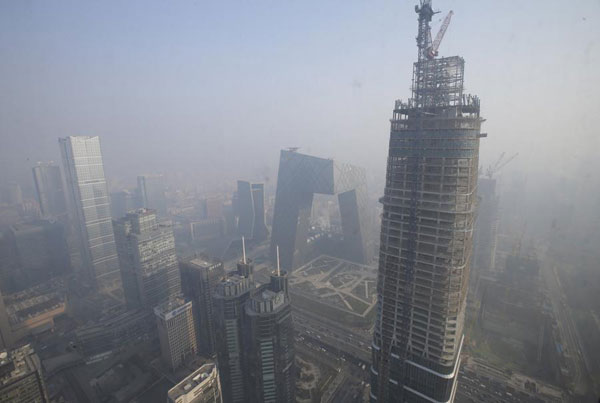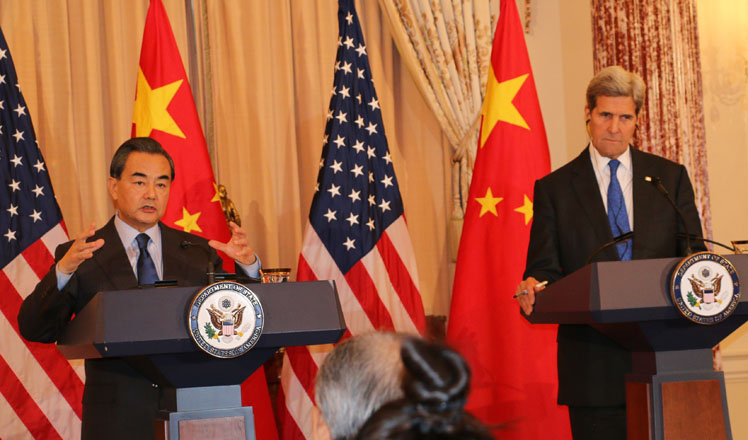Beijing-Tianjin-Hebei region can reach air quality standard but going will be tough
Updated: 2016-02-24 11:13
By Liu Wei(chinadaily.com.cn)
|
||||||||
 |
|
Construction sites and buildings are pictured amid heavy smog, on the third day after China's capital Beijing issued its second ever "red alert" for air pollution, in Beijing, China, on Dec 21, 2015. [Photo/Agencies] |
China's Beijing-Tianjin-Hebei region, the most polluted area in China, may solve the air pollution problems in 2030, but only with the joint effort and full support from all cities and industries, said a report released on Tuesday.
Experts were optimistic about achieving the goal to improve the air quality to the national standard but also stressed the project is tough and needs cooperation from every part of society and efficient practice.
He Kebin, head of the School of Environment of Tsinghua University, said the region cannot ever meet the air quality standard if it just means to deal with the greenhouse gas emissions.
"Industry structure and energy structure have to be re-adjusted drastically," said He.
The region is home to China's largest steel and iron manufacturers and some of the most polluted cities in the world. The steel, coke and cement industries are the biggest contributors to greenhouse gas emissions.
In the region, the service industry will nearly take over as the most crucial industry for economic development while heavy industry would fade away by 2030.
Tackling the smog isn't limited to the region. According to the report, the air pollution in neighboring cities and areas may jeopardize the air quality by about 15 to 25 percent if Beijing-Tianjin-Hebei region makes any progress.
This means that all cities must work together to deal with the air pollution problem.
Jiang Kejun, a research professor in Energy Research Institute National Development and Reform Commission, said the region needs to strengthen the strategy of low emissions and watch out for the next round of industrial overcapacity.
He said sectors like medical, education, travel and environment will be the next hits in the service industry as people have high demand and higher requirements for such fields.
This is the first report using quantitative methods to analyze the smog in Beijing, Tianjin and Hebei, released by Tsinghua University, Energy Research Institute National Development and Reform Commission, and Energy Foundation China.
- Test on rats shows air pollution increases risk of obesity
- China taking pollution fight to local level
- Beijing to raise threshold for issuing air pollution 'red alerts'
- Beijing records 46 days of heavy pollution in 2015
- Firework bans help cut pollution
- Tough rules will cut marine pollution
- Consult public on pollution fight
- Top court upholds record penalty of $26m for water pollution
- New environmental guidelines shift focus, add two more air pollution targets
- Shaanxi's anti-pollution steps turn Tongchuan's sky blue
- Ministry debunks viral Web rumor on pollution
- Road pricing vs car ban to control air pollution

 Matters of state
Matters of state
 Students begin new term with lucky bags and red envelopes
Students begin new term with lucky bags and red envelopes
 The life of a postpartum care worker
The life of a postpartum care worker
 Top 10 most Internet-savvy banks in China
Top 10 most Internet-savvy banks in China
 To eat or not to eat? Delicious and adorable art
To eat or not to eat? Delicious and adorable art
 12 photos you don't want to miss about Chinese Lantern Festival
12 photos you don't want to miss about Chinese Lantern Festival
 The world in photos: Feb 15 - 21
The world in photos: Feb 15 - 21
 China Daily weekly pictures: Feb 13-19
China Daily weekly pictures: Feb 13-19
Most Viewed
Editor's Picks

|

|

|

|

|

|
Today's Top News
What ends Jeb Bush's White House hopes
Investigation for Nicolas's campaign
Will US-ASEAN meeting be good for region?
Accentuate the positive in Sino-US relations
Dangerous games on peninsula will have no winner
National Art Museum showing 400 puppets in new exhibition
Finest Chinese porcelains expected to fetch over $28 million
Monkey portraits by Chinese ink painting masters
US Weekly

|

|








